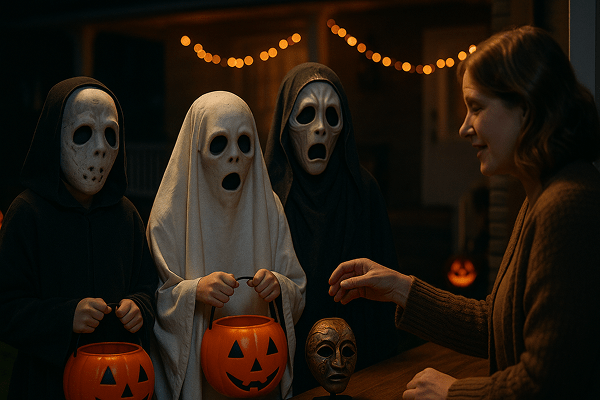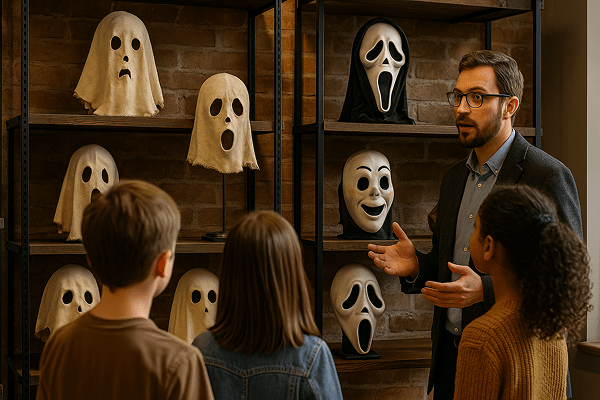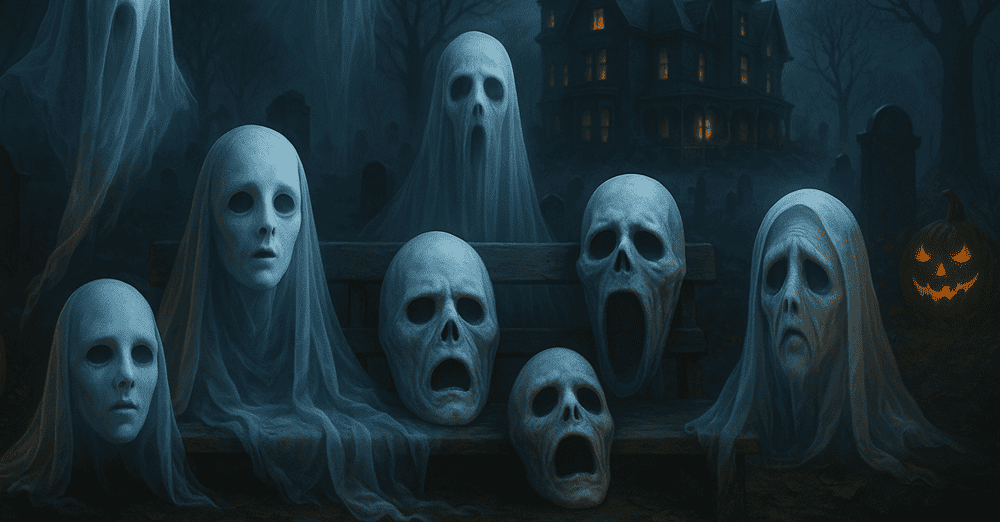Halloween Ghost Masks are among the most evocative and enduring symbols of the Halloween season. Instantly recognizable for their spectral, haunting appearance, these masks typically feature pale or white faces, hollow eyes, flowing or tattered edges, and an ethereal, otherworldly quality. Some are minimalist and abstract, echoing the classic “sheet ghost” or skull motif, while others are intricately detailed with translucent effects, eerie expressions, and glowing features. Rooted in the traditions of North America and Europe, Halloween Ghost Masks have become globally popular since the twentieth century, symbolizing humanity’s fascination with the supernatural and the mysteries of the afterlife. For collectors and enthusiasts, platforms like toddmasks.com provide in-depth galleries and resources on ghost mask artistry.
Historical Origins of Halloween Ghost Masks
The concept of the ghost mask has ancient roots in folklore and ritual. The word “ghost” derives from the Old English “gast,” meaning spirit or soul. Throughout history, masks have been used in rituals to honor or appease the spirits of the dead, especially at liminal times like Samhain (the Celtic predecessor to Halloween) and All Hallows’ Eve. Early ghost masks may have been made from animal hides, painted wood, or fabric, and were worn to disguise the living from wandering spirits or to channel ancestral forces.
As Halloween evolved in the nineteenth and twentieth centuries, particularly in the United States and the British Isles, the ghost became a popular subject for costumes and masks. The design shifted from simple veils or draped sheets to more elaborate latex, plastic, or silicone masks, especially with the rise of commercial Halloween products in the 1950s and 1960s. Classic ghost masks became a staple alongside witches, skeletons, and Zombie Masks, which often share a similar fascination with the supernatural and the undead.
Cultural Significance and Symbolism of Halloween Ghost Masks
Halloween Ghost Masks carry deep symbolism, embodying society’s collective anxieties and hopes about death, the afterlife, and the spirit world. In Western culture, ghosts represent the souls of the departed, unfinished business, or unresolved emotions. Wearing a ghost mask on Halloween allows participants to play with the boundary between life and death, confronting fears in a playful, communal setting.
Spiritually, ghost masks have been used to communicate with ancestors, honor the dead, and protect the living from malevolent forces. Myths and legends about vengeful spirits, friendly ghosts, and haunted places abound, and these stories are reflected in the design and use of ghost masks. Socially, the masks serve as a tool for storytelling, satire, and community bonding, whether worn by children for trick-or-treating or by adults in haunted attractions.

Materials and Crafting Techniques of Halloween Ghost Masks
Traditional ghost masks were made using simple materials: white fabric, gauze, papier-mâché, or carved wood, often with cut-out eyes and hand-painted features. Modern ghost masks utilize a wide range of materials and advanced techniques, including:
- Latex and silicone: For flexible, realistic, and comfortable masks.
- Plastic and vinyl: Lightweight and easily mass-produced for commercial costumes.
- Fabric overlays: Gauze, mesh, or tulle to create translucent or flowing effects.
- Foam and resin: For sculpted, three-dimensional details.
- LED lights or glow-in-the-dark paint: To create haunting, supernatural effects.
The crafting process may involve sculpting, molding, casting, airbrushing, and fabric draping. Decorative elements such as artificial cobwebs, sequins, or reflective materials enhance the ghostly aura. Regional differences exist, with some cultures favoring minimalist styles and others using elaborate ornamentation. Color symbolism is crucial: white for purity, death, and the spirit world; black for mystery; blue and green for supernatural energy.
For mask-making tutorials and interviews with contemporary ghost mask artists, visit toddmasks.com.
Functions and Uses of Halloween Ghost Masks
Halloween Ghost Masks serve multiple functions in traditional and modern contexts:
- Ritual and ceremonial use: Echo ancient practices of disguising the living from the dead or channeling spirits during Halloween, Samhain, or All Souls’ Day.
- Theatrical and performance application: Essential in haunted houses, horror theater, ghost walks, and storytelling events.
- Festival and holiday use: Worn by trick-or-treaters, partygoers, and parade participants for both fright and fun.
- Contemporary use: Popular in horror-themed entertainment, cosplay, viral social media content, and even art installations.
Over time, ghost masks have shifted from ritual objects to symbols of celebration, creative expression, and communal play.
Regional Variations of Halloween Ghost Masks
While the “sheet ghost” is a universal symbol in North America and Europe, regional variations abound:
- United States and UK: Focus on minimalist white masks, skull motifs, or pop culture variations inspired by movies and urban legends.
- Japan: Ghost masks (yūrei and obake) are inspired by traditional folklore, kabuki theater, and festivals such as Obon.
- Mexico: Incorporate calavera (skull) and spirit motifs, blending ghost imagery with Día de los Muertos traditions.
- Eastern Europe: Ghost masks may incorporate Slavic legends of restless spirits, with more somber or ornate designs.
Local artists adapt mask materials and styles to fit community stories, rituals, and contemporary trends.
Famous Examples and Notable Collections of Halloween Ghost Masks
Some of the most famous ghost masks are inspired by classic horror films and folklore:
- “Scream” mask: Though technically a “Ghostface,” it has become one of the most iconic ghost masks in modern pop culture.
- Vintage Ben Cooper and Collegeville ghost masks: Popular in mid-twentieth-century America.
- Museum collections: The Museum of Pop Culture (MoPOP, Seattle), The National Museum of Funeral History (Houston), and international folk art museums.
- Private collections: Rare artist-signed masks, screen-used props, and historic fabric ghost masks.
Digital galleries and expert commentary on ghost masks can be found at toddmasks.com.

Influence of Halloween Ghost Masks on Art and Culture
Halloween Ghost Masks have had a significant impact on visual art, literature, cinema, theater, and music. Their ethereal forms inspire painters, sculptors, and costume designers. In literature, ghost masks symbolize the unknown, the boundary between worlds, and the persistence of memory or guilt.
In film and theater, ghost masks are used to create atmosphere, suspense, and emotional resonance. Fashion designers sometimes reference ghost motifs in avant-garde collections, while musicians use ghostly imagery in album art and stage performances. The continued evolution of ghost masks ensures their place in both traditional and contemporary cultural expression.
Contemporary Status and Preservation of the Ghost Mask Tradition
The tradition of Halloween Ghost Masks thrives today, with new designs emerging every year. Master artisans and independent makers use innovative materials, digital sculpting, and eco-friendly processes. Online tutorials, workshops, and maker communities help beginners and professionals refine their craft.
Ghost masks remain popular in haunted attractions, horror conventions, virtual reality experiences, and art exhibits. Museums, educational programs, and platforms like toddmasks.com are crucial for preserving and sharing the history, artistry, and cultural meaning of ghost masks.
Collecting and Acquiring Halloween Ghost Masks
The market for Halloween Ghost Masks ranges from accessible store-bought items to rare, hand-crafted, or artist-signed collectibles. Authentic masks can be found at costume shops, conventions, auctions, and online platforms such as toddmasks.com. Value is determined by:
- Material and craftsmanship
- Artistic reputation and innovation
- Provenance and association with films or events
- Condition, rarity, and documentation
Collectors should support living artists, seek quality and originality, and consider ethical and legal aspects of acquiring masks, especially for older or culturally significant pieces.
